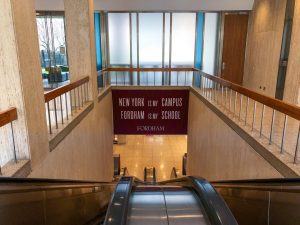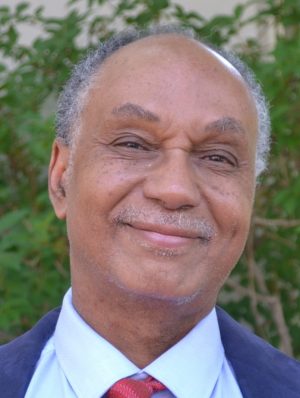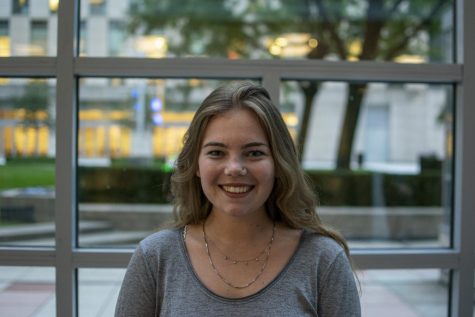What Fordham’s Reopening Plan Means for Fall Semester
Fordham Forward, a 35-page document, details procedures and protocols to safely reopen
July 8, 2020
For months, students, faculty and administration have been waiting for communication from the university on what to expect for the fall 2020 semester. On June 30, the Rev. Joseph M. McShane, S.J., president of Fordham University, shared a community-wide email confirming that the university plans to reopen for the fall semester and a 35-page document discussing procedures and protocols titled Fordham Forward.
McShane confirmed that the fall semester will begin as scheduled on August 26. However, in order to do so, the university explained that it will “proceed cautiously with repopulating the campus while minimizing risks to health and well-being of each member of our community.”
Returning to Campus
The plan to restart Fordham is designed in a four-phase approach that is closely tied to Gov. Cuomo’s health metrics. The first phase will allow essential employees — which Fordham deems as maintenance, information technology, residential life and construction works — to be allowed back on campus as needed.
There are no concrete dates on when the university will enter each phase, as Fordham will have to obtain authorization from the Regional Control Room in order to proceed from each phase to the next. There will be a two-week period in between each phase to ensure that health metrics are not deteriorating, and it is possible that the university will have to revert backward in phases if there is an obvious decline.
In the Fordham Forward plan, the university did recognize that some members of the community may not be comfortable returning to campus for the fall semester. Community members deemed high-risk were encouraged to discuss options with their doctor about returning to campus.
Faculty and employees who self identify as high-risk in accordance with the Centers for Disease Control and Prevention (CDC) guidelines are also encouraged to apply for accommodation from the Office of Human Resources Management.
Students not interested in returning to campus will have to request accommodations that will be evaluated by Student Affairs, and specific colleges and schools will be involved in coordinating options to complete courses remotely.
Some students are already reporting concerns about returning to NYC, citing fears of high infection rates in the city and on campus. Sydney Costales, Fordham College at Lincoln Center (FCLC) ’21, a rising senior from Honolulu, Hawaii, is unsure if traveling back to the city is the right decision for her.
Costales has been safely quarantining with her family since the spring 2020 semester moved online. The Hawaii Department of Health has reported only 975 cases as of July 3, so her life there is slowly and safely returning to normal.
“I want to go back to New York, but my mom is so worried about everything in the city getting bad again. She’s so sure that the second wave is gonna hit hard there and that everything will shut down again,” Costales said. “It’s getting much safer in Hawaii so my mother might not let me go back to New York.”
The question of how international students and students from states with high infection rates will be able to return to campus remains unclear.
Mabel Gwen Lee, FCLC ’21, lives in Malaysia and is unsure if she will even be allowed to travel back to the United States for the semester.
“The Malaysian government is not allowing anyone to leave the country till the end of august unless you have a student visa, but I’m not sure if that applies to the states,” she wrote.
The document explains that Fordham will follow CDC and New York state recommendations about a 14-day quarantine, but no information was provided on where or how these students will be able to quarantine if they are not allowed on campus.
Testing and Monitoring Health of Community Members
To ensure that those returning to campus are not infected with the virus, the university has developed and plans to institute a “rigorous pre-screening program, daily symptoms self-monitoring, and testing of those who are symptomatic or have been exposed to a COVID-positive individual.”
All returning members of the Fordham community will require pre-screening before they are allowed to enter campus for the first time and will be continuously monitored throughout the semester.
At Rose Hill, Fordham has partnered with Montefiore Medical Center to offer diagnostic testing on campus. There are currently conversations with Mount Sinai West in order to offer the same resources for the Lincoln Center campus. All testing will be coordinated through University Health Services.
Community members will be asked to engage in an ongoing screening through a self-certification process each time they arrive on campus. If a student or employee is not cleared, they will be advised to be tested for COVID-19 or to quarantine for a period of time.
Life on Campus
Fordham will comply with the New York State Department of Health directives such as providing personal protective equipment, reporting symptoms of COVID-19 and providing physical distancing instructions, among others.
All members of the community will be required to complete online public health training. Students’ training will focus on safety, health and wellness, and specific content will be created for residential students.
Students, faculty and employees are expected to wear face coverings while in any public settings on campus and when interacting with anyone on Fordham property. While the university encourages people to come to campus with their own face covering, they have confirmed there will be protective equipment available on site.
The school calendar is assumed to be the same as previously scheduled, as nowhere in the Fordham Forward plan mentions any changes to the semester dates.
Many other colleges in the United States have modified their fall semester schedules to end before Thanksgiving to eliminate the risk of students traveling home and back to campus.
Instead, Fordham is encouraging all students, faculty and staff to stay within the NYC area throughout the duration of the fall semester.
While Julianne Holmquist, FCLC ’21, admits that she hasn’t been too focused on not being able to travel to see her family in California, she did say that “not going home for a whole semester will be tough, but I have great roommates and we’ll definitely help each other through it.”
She added, “My mom is mostly concerned that if I get sick and hospitalized, she probably won’t be able to get me.”
Residential Halls
Fordham will welcome residential students back to McKeon and McMahon Halls for the fall semester at a much lower density. Communication about new community expectations, safety rules and guidelines will be shared with residential students before the start of the semester.
New student move-in is still scheduled for August 23, but new policies and procedures will be implemented to ensure a revised move-in timeline and process that will allow for sure social distancing and lower population density.
Other steps include eliminating converted triples in first-year halls, suspending all non-resident guest visitation and designating specific housing areas for students who need to isolate or quarantine.
Students will be asked to adhere to university policies about social distancing when they both are on and off campus. However, even with the precautions, many students are still concerned about living in such close proximity.
Beckett Schiaparelli, FCLC ’23, who is moving into McMahon Hall in the fall, is worried about the virus spreading.
“There’s very little doubt in my mind that a campus outbreak is likely if a bunch of college age students from all across America and around the world are sort of haphazardly crammed into a building the size of McMahon together,” he said.
During the spring 2020 semester, Jenifer Campbell, senior director of the Office of Residential Life, confirmed that there were 771 residential students in McMahon and 431 in McKeon Halls. While the plan did state that there will be new procedures for floor meetings, programming and activities, and staff duties, little information was given about social distancing in dorms or in the elevators.
Sharing Schiaparelli’s anxieties of another outbreak, some students opted out of living on campus this semester after the stress of the spring semester closing.
“The main thought I had when we finally got a plan from Fordham was like why should I trust that they won’t kick us out of housing/refund us/ etc. if things go awry with the pandemic rates?” Katie Heaton, FCLC ’23, said.
Heaton, who lived in McKeon last year, decided to move out of the residential halls in order to ensure more control of her housing situation and try to create some stability as she returns to New York.
Commuting Students
Throughout the Fordham Forward plan, there was little mention of how commuting students who live off campus should prepare for the semester.
The Metropolitan Transportation Authority has developed operational plans to try to ensure that public transportation is as safe as possible. While Fordham did not express concerns about students commuting to campus, students have.
James Groenier, Gabelli School of Business at Lincoln Center ’23, is another student who, like Heaton, decided to move off campus after moving out of McKeon on such short notice in the spring. When Fordham announced the plan on Instagram, Groenier commented on the post.
“As someone who will not be living on-campus next semester, having to commute multiple times a week via public transit and use the facilities at LC would not make me feel safe,” he wrote.
Groenier told The Observer that “it felt like the university’s response didn’t fully address the safety of commuters and only came from the perspective of how the Rose Hill campus operates.
“In addition commuters have to use public transit. This not only puts them at risk, but puts everyone else they are around on campus at risk too,” he said.
Due to concerns about living in New York City, some students might have longer commutes than normal.
For example, Gab Greico, FCLC ’21, commuted from Brooklyn to the Lincoln Center campus during the 2019-20 school year. However, after the concentrated outbreak in Manhattan, she and her family decided that she will commute from her home in New Jersey this year.
“My parents really don’t want me being in the city and taking public transportation in the city during the pandemic,” she explained.
Instead, Greico will now take an hourlong train from central New Jersey to Penn Station and the subway to Columbus Circle three times a week. Greico admitted that she still is not altogether comfortable about taking public transportation, but that she has designed her class schedule to try to limit her amount of time on campus.
“I think the screening is a good idea, but there are far too many commuters from all over for that to be truly effective,” Greico said.
There are also obvious concerns that commuters could bring the virus with them on campus. The plan explains that spaces on campus will be designated for commuter students to access technology but gave no other commuter-specific information.
Classes
Fordham will adhere to the existing fall 2020 schedule in order to avoid students having to re-register for classes.
Each classroom will operate at one third of its original seating capacity and might be redesigned in order to establish 6-foot social distancing. The university also plans to upgrade any technological resources in classrooms to be prepared for a flexible hybrid pedagogy.
There will also be efforts to de-densify academic buildings during rush periods in between classes. The plan listed designating up and down stairways, expanding time between courses to 20 minutes, and providing sanitizing wipes and hand sanitizers as some of the changes that might be made.
Classes will be instructed through a Flexible Hybrid Learning Environment (FHLE). This model was first presented to the Fordham community in a May 11 email from Provost and Senior Vice President for Academic Affairs Dennis Jacobs.
The FHLE model will allow for some course material to be delivered asynchronously, which will allow students to complete their work on their own schedule. Other content, such as interactive components, discussions or small group meetings will be taught synchronously.
This model will ensure limited classroom capacity: Jacobs explained that “the flexible hybrid learning environment that we have adopted will enable an instructor, for instance, to divide the scheduled class time per week into two or more time slots and meet with smaller groups of students weekly in the various time slots.”
The Fordham Forward plans detail extra support that will be given to instructors who are adapting to teaching through technology. There will also be analytical tools to monitor how students and faculty are responding to technological tools and if any changes must be made.
Classes that are largely experiential in nature, such as lab-based, dance, theatre and music programs will receive special attention to developing solutions.
FHLE also ensures flexibility if the university has to pivot to fully remote instruction again.
Another Campus Shutdown
The university will continue to monitor the seven health metrics in the New York City area on a daily basis and plans to remain in close contact with the Department of Health and NYC Regional Control Room.
A shutdown will be triggered in the event that the number of positive COVID-19 cases at Fordham overwhelms the university’s quarantine capacity or if state and local health authorities decide that New York City must take measures to stop the spread of the virus.
The Forward Plan lists a series of “Ramp-Down Activities” that are designed to support a prompt and efficient shutdown of campus. Some of these efforts include suspending face-to-face instruction, moving residents out of their residence halls and/or discontinuing food services.
At that point, Fordham will continue to instruct classes, as the asynchronous portions will not be affected, and the synchronous components will be transitioned to videoconferencing.
















